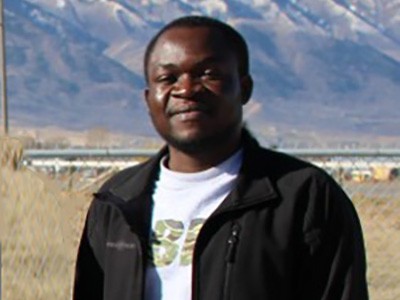USU Researchers' Work in National Report on Extreme Weather
USU graduate student Boniface Fosu is the lead author of the paper, Explaining Extreme Events of 2015 from a Climate Perspective, released this week at the American Geophysical Union's annual meeting.
Climate scientists at Utah State University are among the contributors to a special supplement to the Bulletin of the American Meteorological Society (BAMS), Explaining Extreme Events of 2015 from a Climate Perspective, released this week at the American Geophysical Union’s annual meeting.
Their work examines the snowpack drought Washington State experienced in 2014 and 2015, and attempts to understand the causes of the drought and what it means for the future. A “snowpack drought” happens when a region receives normal precipitation, but higher-than-normal temperatures cause the precipitation to occur as rain or to occur as snow but melt too quickly to be useful to communities in the area.
“For some people, it’s hard to believe that there can be a drought with normal levels of precipitation,” said Boniface Fosu, lead author of the paper. “In Washington, it led to the declaration of a state of emergency. Wildfires, dry soil, low crop yields and any other problems associated with a normal drought can be seen with a snowpack drought.”
The research shows that a snowpack drought may occur due to naturally low precipitation and the acceleration of human-induced climate change.
“The key thing we discovered in this paper is that natural variability in climate can cause warming,” Fosu said. “Natural variability over the Pacific Ocean drives changes in temperature and precipitation in the Pacific Northwest. So there’s natural warming, and when you add human-induced climate change, it makes the problem worse.”
In that case of the Washington snowpack drought, the state received near normal precipitation statewide from November 2014 to March 2015, but also experienced much higher temperatures.
Simon Wang, associate professor in USU’s Department of Plants, Soils and Climate said, “The worst thing we found is that there is a recurrence of very bad drought combined with higher temperatures and that pattern will be growing more extreme. They are the droughts people need to prepare for and they come at a frequency of about 30 years.”
Researchers can study this relationship to predict what the future might look like, according to Fosu. Warmer water temperatures in the north Pacific also contributed to the increase of rain over snow and warmer temperatures that quickly melted the snowpack, Wang said.
USU climate researchers previously published a study linking increased early season rainfall and hotter temperatures to increases in wildfire severity. The relationship has implications for states across the West, Wang said, as abundant early spring rain spurs plant growth which produces abundant fuel for fires when temperatures turn hotter than normal and plants quickly dry out earlier in the summer.
The full report is available on the National Oceanographic and Atmospheric Administration (NOAA.gov) and American Meteorological Society (ametsoc.org) websites.
Related Link:
Department of Plants, Soils and Climate
Writers: Shelby Ruud Shelby.ruud@usu.edu; Lynnette Harris, 435-797-2189 lynnette.harris@usu.edu
Contacts: Boniface Fosu, bonifosu@aol.com; Simon Wang, simon.wang@usu.edu
Simon Wang, associate professor in USU's Department of Plants, Soils and Climate.
TOPICS
Research 879stories Climate 151storiesComments and questions regarding this article may be directed to the contact person listed on this page.










